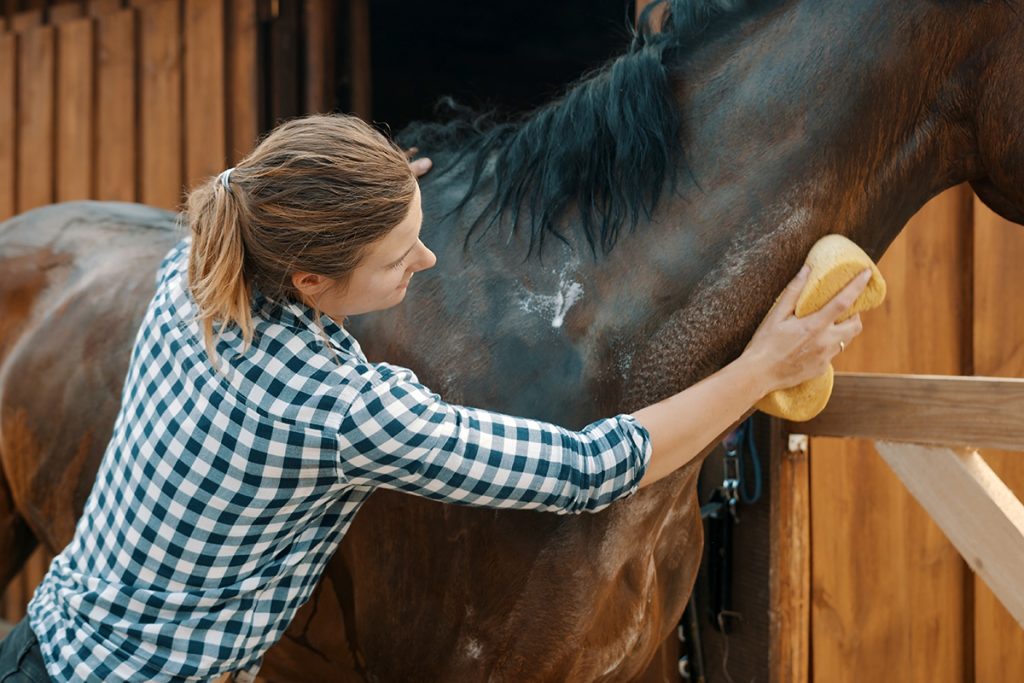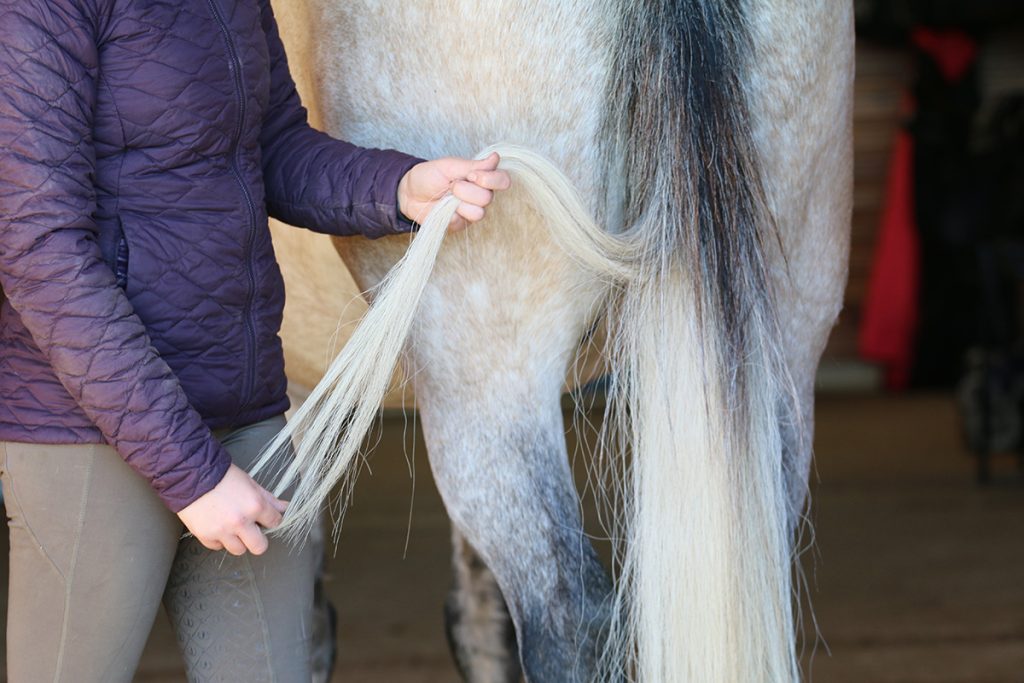Behind every shiny horse is not only good nutrition, regular routine care, and hours of currying, but also an assortment of the right products to clean and polish. To make the most out of your glam session, we consulted a top grooming product expert for tips on choosing the right tools for the job.

Product Prerequisites
With many products to choose from, check that the ones you’re applying are gentle, pH balanced, and made with quality ingredients, says Devon Katzev, president and product developer at Straight Arrow, makers of the Original Mane ’n Tail product line, as well as the Cowboy Magic and Exhibitor’s brands.
The way you use the products makes a difference, but ultimately, he notes that trial and error will help you assess what works.
To achieve best results, read the directions on the bottle. Manufacturer’s instructions are intended to maximize performance.
And spoiler alert: There’s no free pass from regular grooming. Even with the best products, good old-fashioned currying and “elbow grease” are key for grooming success.
Shampoo Secrets
Before you head to the wash rack, make sure the shampoo you’re using was made specifically for horses. While human shampoo is usually gentle enough to be safe for horses, it’s not designed to effectively cleanse the dirt that horses get into, or their coarser hair and sensitive skin.
“Horses love to roll and get dirty, and equine shampoos in general are designed to clean and compensate for the extra dirt,” says Katzev. “Plus, conditioning for their extra-thick manes and tails is essential to keep them long and flowing.”
For general cleaning, he says you’ll want a gentle pH-balanced formula, ingredients that clean and nourish, and value for the amount you’ll be using.
Avoid harsh detergents, such as household cleaning items. Products made for laundry or dishes are extremely drying to the horse’s skin, strip the natural oils from the horse’s coat, and leave the hair dull and brittle.
The Right Product for the Job
You’ll also want to choose the right shampoo for the job. Equine shampoos may be formulated for routine cleaning and frequent use; contain medicated treatment for skin; or be made to enhance color or shine.
With skin problems, Katzev recommends consulting your vet and doing your research to better understand what you are looking to treat, such as rain rot, girth itch, scratches, et cetera.
Again, for best results, read the product directions—some shampoos are designed to be diluted, while others work best applied full-strength directly to the coat.
Coming Clean
Technique for bathing your horse matters, too. Use a sponge for thorough application, currying while the shampoo is on the horse, cleaning down to the skin and bringing all the dirt to the surface to be washed away. Rinse the shampoo thoroughly from your horse’s coat, as leftover suds may cause itchy dry skin, dandruff, or dullness.
Good water pressure helps to get deep down into the coat to clean, says Katzev. He also recommends adding basic tools in your bath kit, such as a sponge, sweat scraper, grooming gloves or a currycomb.
After bathing your horse, Katzev suggests inspecting the results. Often, he says, dander and fine dirt under the coat are the culprits for a less than stellar shine. In addition to causing a dull appearance, embedded dirt and dander can irritate the skin if rubbed by a saddle, girth, or other tack.
To check that your horse is truly clean, Katzev advises running your hand backwards against the coat randomly in different areas on the horse to see if dander still exists underneath the hair.
“If you still see dirt or dander, you didn’t wash [the horse] thoroughly,” he says. “In that case, you may need more of the shampoo applied directly to get more concentration of the product to clean instead of diluting it in a bucket. Plus, some good water pressure also helps for rinsing.”
If you groom and wash your horse regularly, Katzev notes that you won’t need as much shampoo. Cleanliness is important: dirty skin can get itchy and dry.
It may take some trial and error to see what works best for you and your horse, but the results will speak for themselves.
“If your true desire is shine for the coat, then [it] will obviously show on the final finish,” says Katzev.
Condition
Conditioners add moisture to soothe and nourish skin, strengthen hair, and add smoothness and shine. You can use a rinse-out product while bathing your horse, or a leave-in product to provide additional conditioning, including sprays and grooming oil.
With grooming oil, choose a product made for horses. After bathing, add a dollop to a bucket of water, sponge it all over, then body scrape the horse. Or pour some on a rag and run it over the horse after your everyday grooming routine.
It might feel like an extra step to add a conditioner, but with the damaging environment a horse’s hair and coat endure, from the sun and harsh weather to dirt, sand and sweat—plus frequent bathing that can strip the oils from the skin and coat—the extra moisture is beneficial.
Detangling Manes and Tails
Detanglers create a friction-free slip to reduces tangles and knots. They also add conditioners to strengthen hair, prevent damage and make manes and tails more manageable. In the quest for a long, flowing mane and tail, a good detangling product is key.

Between spray detanglers and serum detanglers, which should you use?
“Both types of products approach the same problem in a different way,” says Katzev. “Spray detanglers are usually water-based emulsions designed to spread out quickly over hair without necessarily having to use your hands. For quick touch-ups and daily maintenance, this application will speed up [your grooming].”
It’s important to give the product time to work before you start brushing or combing the hair. Let it sit for a few minutes—especially on the tail—before you start to comb. Start at the bottom and work your way up.
Serum or gel detanglers are more concentrated and are applied by hand to the mane and tail.
“Serums can be helpful in heavily knotted hair when your concern is to work it out by hand and detangle carefully to prevent any excess tearing of the hair,” says Katzev. “They also have a thickening and smoothing effect, plus [make] a great overall appearance and shine.”
To apply, he recommends pouring the serum into your hands first and working through the hair.
Time to Shine
Coat polish and shine sprays will give your horse an extra glow, as well as additional benefits for your everyday grooming routine. These silicone-based products repel dust and dirt to cut down your grooming time by coating the hair shaft, making it more difficult for stains to set and preventing mud from clinging to the coat.
These sprays also detangle manes and tails, and can prevent blanket rubs.
Apply coat polish after bathing while the horse is wet, after removing excess water from the coat. To apply to a dry coat, groom your horse thoroughly first to remove dust and dirt. Spray evenly, let it dry for a few minutes, and then buff to a shine with a towel or brush.
These products are slick, so be careful to avoid the saddle and girth area. You’ll also want to skip manes or tails that will be braided soon, since the hair needs to be a little grippy.
Oil-based finishing sprays offer a highly reflective shine for the show ring but aren’t designed for everyday use. The oil attracts dust, so these products are best reserved for right before going into the show ring.
While elbow grease is the tried-and-true path to a shiny coat, busy equestrians often fall short on time to devote to currying and brushing.
Ultimately, Katzev believes the way we perceive grooming is important—to value the process and not see it as a chore. Instead, he says, think of grooming as quality time to spend with your horse, and enjoy it.
“Take the time if you can with your equine friend and enjoy—that’s why you are both together,” he says.
This article about horse grooming tips appeared in the August 2024 issue of Western Life Today magazine. Click here to subscribe!


